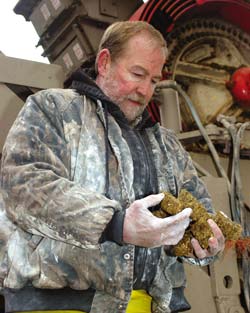Making The Switch – Biomass Holds Potential For Farmers

Green dust filled the frigid air as Talladega County farmers David and Doug Wilson watched trailer-truck-size machines grind and compress baled hay into cubes. For the Wilsons, the noisy process is the latest phase of an experiment that began five years ago when they agreed to plow up 270 acres of pastureland and plant switchgrass for the generation of electricity.The third-generation farmers said they are hopeful the dense cubes will finally make switchgrass a viable alternative to coal.”My goal is to get this out of the experimental stage to where they are burning it all the time,” said David Wilson. “I would love to have 3,000 acres in biomass production and eliminate having to plant a crop every year.”As optimistic as that sounds, Wilson’s dream may not be altogether unrealistic. Increasing pressure on energy companies to use environmentally friendly, renewable fuels could create a huge market for biomass crops like switchgrass.Currently, biomass costs about twice as much as coal on an energy basis and accounts for only about 3 percent of the total U.S. energy consumption, according to the Energy Information Administration. But Dr. David Bransby of Auburn University said a bill that stalled in Congress last year could have significantly boosted the use of the alternative fuel by giving power companies a tax credit for co-firing biomass crops with coal.Bransby, who has studied switchgrass production for about 15 years, conducted research which led to the first tests involving the co-firing of switchgrass with coal at Southern Research Institute in Birmingham and at Alabama Power Company’s Plant Gadsden.Initially, researchers tried mixing switchgrass directly with coal, but the lighter grass would not flow properly through the coal-handling equipment. To remedy the problem, the scientists ground the biomass and injected it directly into the boiler using large fans. This proved successful, but it required the construction of a separate handling system.Dr. Doug Boylan, a research engineer with Southern Company, said the cubing process could eliminate this problem.”Cubing makes the grass work more like coal,” Boylan said. “If it works, we can avoid the capital expense associated with building a new system to handle the grass.”Boylan said energy produced from biomass lowers emissions and does not contribute appreciably to the level of carbon dioxide in the atmosphere.These encouraging results mean the development of biomass as an alternative fuel is likely to continue. That’s good news for farmers like the Wilsons, who currently farm 2,500 acres of row crops plus 400 acres of forage crops”We have a lot of grass already established in this part of Alabama,” said David Wilson. “If they can cube and burn any kind of grass–and I don’t see why they can’t–it would give farmers an option of either raising cattle or growing grass. We haven’t had that option until now.”
